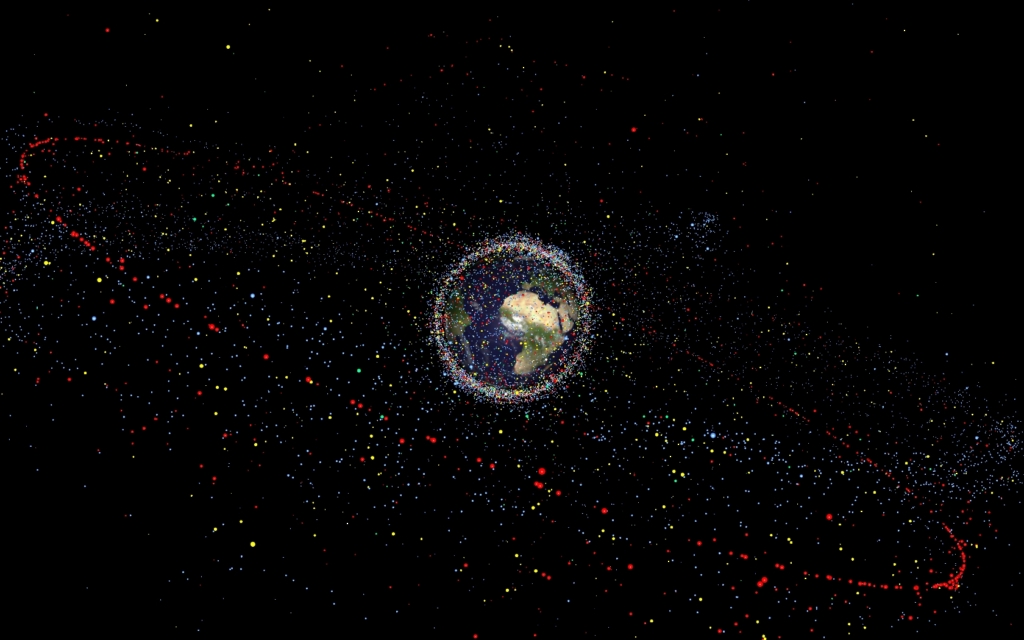Radish to romanesco: A year in vegetables
February 20th, 2025
4 min
This article is brought to you by Datawrapper, a data visualization tool for creating charts, maps, and tables. Learn more.

Hi, it’s Pascal, a developer at Datawrapper. This week I’ll venture out into space to take a look at the stuff in Earth’s orbit and why it’s a problem.
In the last 8 years, humans have launched more objects into space than in the 58 years since the launch of the first satellite “Sputnik 1” combined. These objects include everything from probes, landers, and manned spacecraft to parts of space stations and, of course, satellites. Those are sent to the earth’s orbit to help us communicate, navigate, monitor weather and climate change, and provide imagery of every place on Earth.
However, with rising space activities, a new hazard started to form: space debris, human-made objects (or parts of them) which are no longer functional and don’t have a use.
Let’s look at Earth's orbit and see what kind of objects are up there.
Since 1956, about 15,000 satellites have been launched into orbit, and about 9,800 are still in space. Around 2,600 of these are no longer functional. They were initially launched with no plans for what to do with them at the end of their lives. Getting all the satellites into orbit required a lot of rockets, and some parts stayed there even after they served their purpose.
The vast majority of objects are paint flakes from rockets and fragments of all shapes and sizes created by failures, accidents, collisions, and explosions but also intentional destruction during anti-satellite (ASAT) weapon tests, which can easily create thousands of new pieces.
Based on statistical models published by ESA’s space debris office in Germany, there are over 1 million 1-10cm objects and about 130 million 1-10mm objects in Earth's orbit.
Currently, about 32,000 objects are tracked by the Space Force Base in California using the United States Space Surveillance Network. By observing and monitoring reflections from the sun, the system can determine the size of the object and its distance from Earth. Unfortunately, only a small subset of objects can actually be tracked.
Even the tiniest objects are traveling at several kilometers per second, faster than bullets, and can do real damage to vulnerable parts of space vehicles. To prevent this, spacecraft often have an impact shield (like the “Whipple shield”), which can typically withstand collisions with debris up to 1cm.
To prevent damage or complete destruction from collisions with larger debris, spacecraft sometimes have to move out of their way to avoid oncoming objects. Small satellites without any thrusters (like CubeSats) make use of atmospheric drag to move and adjust their orbits.
Larger spacecraft like the International Space Station (ISS) can use onboard propulsion to move on their own but only does so when the risk of collision is high. In the case of the ISS, a risk of collision does not necessarily mean direct impact but rather that the object will cross through an imaginary box, known as the “pizza box” (4 x 50 x 50 kilometers) around the spacecraft. However, since there are crew members on board, potential collision is riskier.
To put some of the mentioned numbers into perspective, it might help to compare them to things we know. Let’s take all the 1 million objects 1-10cm in size and spread them out evenly in the available space of the low earth orbit (160-2000km). An object about the size of a tennis ball would have space to itself roughly equivalent to one billion Empire State Buildings. While this number is still unimaginable, it might give you an idea of just how much space there is.
The example above might make it seem like the debris and waste is not really a problem because there is just so much space, right? Well, there are a few things to consider:
Fortunately, companies and organizations have started to comply with debris mitigation measures by attempting to follow established rules and guidelines, safely disposing of rockets, and putting satellites in low-altitude orbit where they burn up naturally. Also, more and more satellites in the narrow geostationary orbit move out of the way and into the “graveyard orbit” at the end of their lives. When it comes to weapon tests in space, some countries have already declared a ban on their own testing, but many nations are left to join.
There is a lot more (and probably more accurate) information on all of the topics I mentioned, so if you’re curious, there are a lot of great resources out there. Some of them are linked below.
Note: Please take my calculations with a grain of salt and look up the numbers yourself if you’re curious.
Our World in Data - Space Exploration and Satellites
NASA - Space Debris and Human Spacecraft
NASA - Orbital Debris Quarterly News
inmarsat - Space explained: How much space junk is there?
ESA - The current state of space debris
ESA - Space debris by the numbers
Wikipedia - Collision avoidance
That’s it from me for this week! I really enjoyed exploring this topic and hope you did too. Next week you’ll hear from David, our head of design. Until next time!
Comments